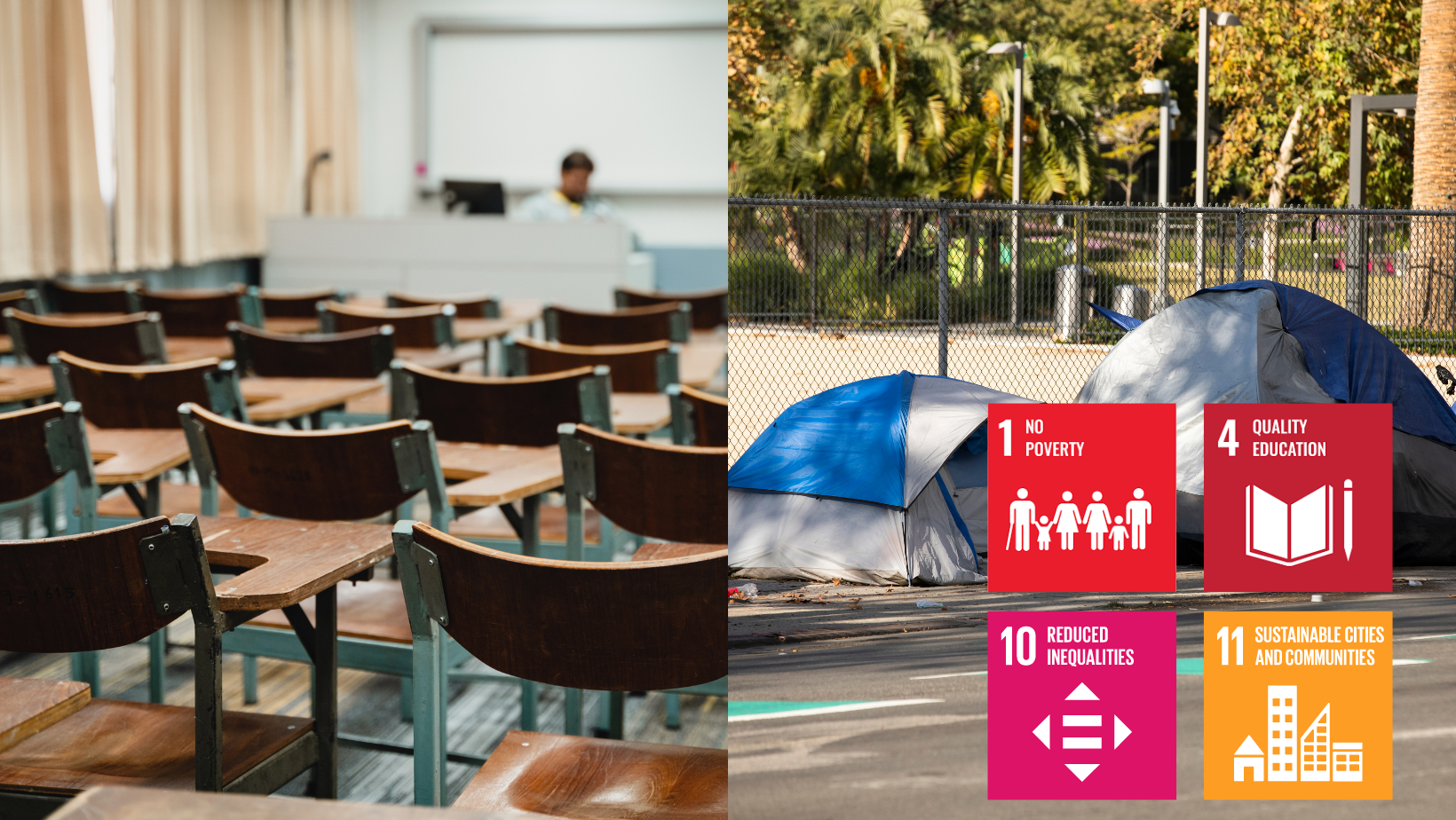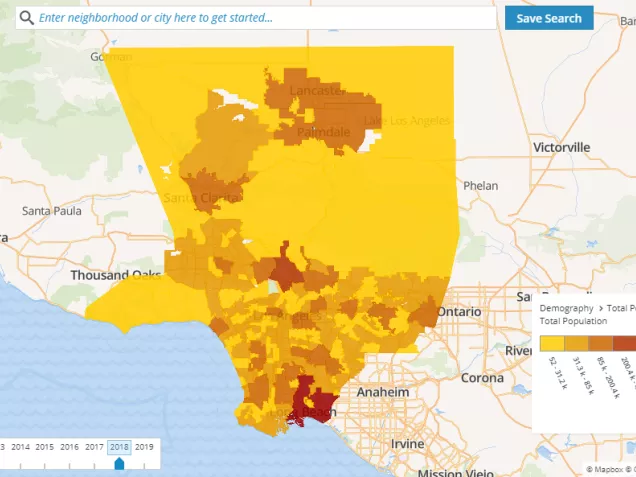
The City of Los Angeles (LA) Mayor’s Office of International Affairs assigned a team of six students to conduct a macroanalysis of the determinants of intergenerational poverty with a focus on the relationship between homeless students’ environment and their educational outcomes. Jack Fernandes ‘20, Micah Kirscher ‘20, Wafa Abedin ‘21, Caroline Diamond ‘22, and Kyler Parris ‘22 represented Occidental College and reported to the Los Angeles Mayor’s Office for International Affairs.
“Leaving no one behind” is a key priority of the 2030 Agenda. Using the lens of the SDGs, our team’s work focused on increasing the educational attainment of students living in motel housing in an area of Los Angeles known as the ‘Sepulveda Corridor,’ as shown below using census tracts on the Neighborhood Data for Social Change Platform.

We defined three deliverables for our ten-week project, with the overall goal of contributing to the city’s understanding of the linkages between homelessness, educational access, student empowerment, and intergenerational poverty, using a case study focused on housing insecure students residing along the Sepulveda Corridor. These deliverables were:
1. A special report on the barriers that unhoused students experience that impede educational success and their ability to escape intergenerational poverty
2. Best practices to inform the Mayor’s Office of Economic Opportunity’s work on the Sepulveda Corridor and throughout Los Angeles
3. Posters and communications materials that can destigmatize homelessness and increase service provision
All research was conducted remotely due to the Coronavirus pandemic, which limited our ability to directly connect with families and students living along the Corridor. Client-focused input and engagement is critical to validate our findings, and we recommend completing this work in the future. We were fortunate enough though to engage directly with several service providers, including the Mayor’s Senior Education Advisor, the Los Angeles Unified School District (LAUSD) Homeless Education Office, New Economics for Women, and North Valley Caring Services.
Overview:
Our client, the Mayor’s Office of Economic Opportunity (MOEO), in partnership with multiple service providers, developed the Sepulveda Corridor Demonstration Project to provide intensive support services for families who are temporarily sheltered. Sepulveda is a major boulevard in the San Fernando Valley where many families, 66% of whom do not speak English at home, and 65.5% of which are not naturalized U.S. citizens, have sought housing in the motels that line the Corridor.
Ultimately, the aim of the Demonstration Project is to bolster families’ resiliencies and connect them with services to transition into permanent housing, while also improving the educational outcomes of their children. The Demonstration Project is capturing metrics that include an increase in school attendance, better access to school-based services and support, and an increase in support for the learning and academic achievements of students.
What Did We Do?:
Focusing on these metrics for student success, our research identified three areas where policy and service-based interventions can have a positive impact: increasing and demonstrating the importance of parent engagement in school, addressing the negative impact of proximity trauma, and removing barriers to the enrollment and attendance of unhoused students.
First, our research showed that parent engagement is integral to the academic success of a child. We found that unhoused families experience layered inequality that impede parent engagement, including a lack of institutional trust in the school system, lower levels of maternal education, language barriers, and citizenship status. Our research found that the Demonstration Project could counter these barriers with two-generational wraparound services, married with consistent home visits that build trust between families, service providers, and the school system.
Second, for students to achieve success, special attention should be given to the trauma resulting from housing insecurity. Our research shows for children, the accumulation of this trauma can impede cognitive development, decrease academic performance, and increase the frequency of behavioral incidents. Thus, unhoused children should be provided with trauma counseling to help build support networks and develop productive coping mechanisms. It is important that these counseling services include strategies to deal with intersectional issues including racial trauma and linguistic isolation.
Lastly, we found that the attendance and enrollment of unhoused students is negatively impacted by a lack of funding for school transportation, housing instability in conjunction with cross-district coordination, the need for families to self-identify as experiencing homelessness, and unsympathetic anti-truancy policies. To minimize the impact of these barriers, we recommend expanding non-permanent housing programs and developing community partnerships with business organizations to generate career exploration and educational development opportunities.
These findings are captured in our final report, which examines the intersecting factors that influence academic success, access, and engagement for unhoused students.
We identified other best practices that may be of use for MOEO or the Demonstration Project in the future. First is to create awareness within school personnel to destigmatize homelessness, and conversely, to ensure families experiencing homelessness know how to access the types of wraparound services that can support student success. We created a mock-up outreach campaign to spread awareness about the provisions of the McKinney Vento Act, as many families miss out on benefits simply due to misconceptions about their rights and housing status.
Second is to use the Neighborhood Data for Social Change (NDSC) platform (a product of the USC Sol Price Center for Innovation) to better define and visually layer data for the neighborhood along the Sepulveda Corridor. Using census tract data, we were able to show how language use, socioeconomic status, and immigration status are represented on the Corridor. The City and other service providers may be able to tailor future outreach and policy recommendations based on these demographic considerations.
Advancing Racial Equity in the SDG Framework:
In addition to advancing the SDGs in Los Angeles, we believe in applying the goals as a framework to progress racial equity and ensure that nobody is left behind, both in our own research and future city policy. With this in mind, we developed a Racial Equity Toolkit to guide our thinking and actively center racial equity, from project inception to project evaluation. It is our hope that this toolkit can be applied to future projects that aim to localize the SDGs in Los Angeles through a lens of racial equity.
Looking forward:
As we conclude this project, LAUSD will shift to fully remote learning due to COVID-19. Parents experiencing housing insecurity and homelessness are often not in a position to provide their children with a quiet work space, reliable internet access, or a device for remote learning. On top of that, many are essential workers who cannot afford to leave their children at home and may be forced to rely on older children to take care of siblings who are not in school. The inherent inequities of online learning will significantly and disproportionately impact unhoused students, who already experience barriers to educational success. Service providers and city policymakers must increase their support through human-centered design that fosters family and student empowerment through education. It is imperative that nations and cities across the world mobilize to build resilience and protect our most vulnerable communities.
The SDGs are a powerful framework for us to understand the cycles of intergenerational poverty and student homelessness in Los Angeles. But, actually doing the work — ensuring that nobody is left behind — is on all of us.
Team Members:
Jack Fernandes, Micah Kirscher, Wafa Abedin, Caroline Diamond, and Kyler Parris Occidental College,
Josephine Gardner University of Southern California
